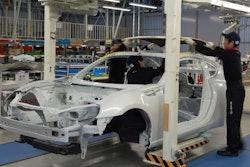Origami Robots
Engineers from the University of Illinois drew inspiration from nature and origami structures to create a robot that moves in a crawling motion — without exerting much energy.
Researchers from the school's Department of Mechanical Science and Engineering noticed a common theme in the movements of certain bacteria or soft plants like the Venus Flytrap.
In both cases, the organisms use the flexibility of their bodies to create an energy-efficient, but very fast, snapping motion.
In order to incorporate those advantages into robotics, researchers used an origami principle called the Kresling crease pattern.
The pattern creates a "buckling tower" effect of expansion and contraction, which engineers used to convert motor rotation into an efficient, crawling gait similar that of an earthworm.
Material design, meanwhile, prevented the primitive robot from slipping backward.
Researchers said that the ability to create a relatively complex system with such simple materials could hold significant promise for robotics — from small, scalable and cheap robots to autonomously deployable structures.
SO, WHAT DO YOU THINK?
Could structural breakthroughs allow manufacturers to embrace robots more quickly? Tell us your thoughts in the comments below.
Warehouse Inventory Drones
For manufacturers, keeping track of stock in modern distribution centers or factories can be a huge and potentially costly challenge. According to MIT, Walmart in 2013 lost $3 billion in revenue due to mismatches between its inventory records and its stock. Also, between 2003 and 2011, the U.S. Army lost track of $5.8 billion in supplies among its warehouses.
So, to help both small-and-large scale manufacturers and distributors better manage their inventory, MIT researchers have developed a system that enables small aerial drones to read RFID tags. However, these drones don’t carry the readers, as it proved unsafe to have them flying in such close proximity to factory workers.
Instead, MIT’s drones come fitted with their own RFID tag, so the drone alternates between relaying the signal of the tagged item it’s locating and its own signal to the reader. This then allows the system to work out how much of the drone’s movement has altered the result, in order to correct it.
MIT’s system is currently being put through a second phase of trials in Massachusetts.
SO, WHAT DO YOU THINK?
What other potential challenges do you think researchers will have with this system of inventory-tracking drones? Tweet me your thoughts @MnetNews or leave your comment in the section below.






















